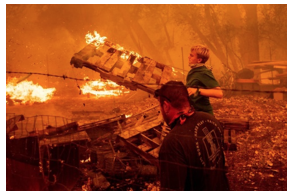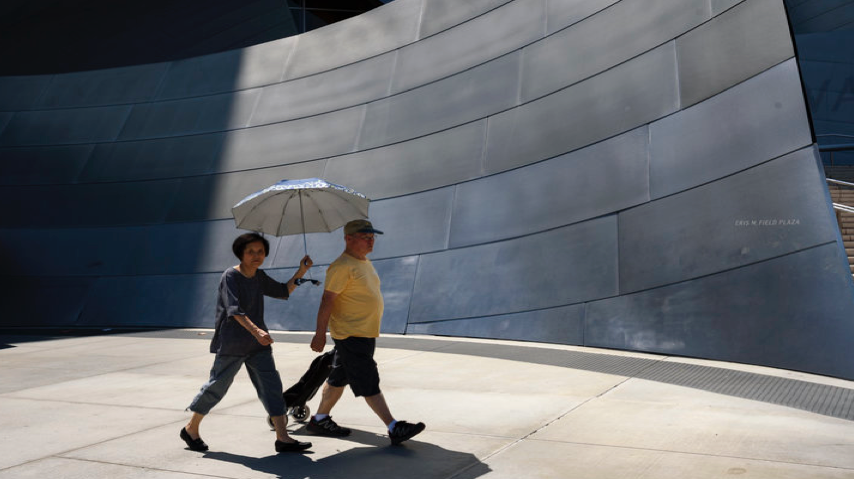CommentsCLIMATE POLITICS--The California Natural Resources Agency just released its fourth Climate Change Assessment, a call to action on rising global temperatures — the state’s first in six years.
In a vast assessment that draws on more than 50 reports on climate change, state officials paint a grim picture of California’s future if greenhouse gas emissions continue at their current rate. Below are five of the assessment’s most unsettling predictions.
As many as 11,000 more people are expected to die.
By 2050, the assessment warns, there may be an additional 6,700 to 11,300 deaths a year in California associated with rising temperatures.
As is the case with many effects of climate change, the consequences will be worse for low-income communities. While a 2018 study cited in the assessment found that increasing air conditioner use by 20 percent would reduce expected heat-related deaths by 33 percent, poorer residents may not use air conditioning during dangerous heat waves because of financial constraints.
Heat waves will last longer.
If business as usual continues with emissions, the assessment says, the average daily temperature in California is projected to increase by 8.8 degrees by 2100.
By midcentury, heat waves in California’s agriculture-rich Central Valley will last an average of two weeks longer than they do today, and they may occur four to 10 times as often in the state’s Northern Sierra region.
Additionally, an “unprecedented marine heat wave” that California has been experiencing in recent years is expected to continue degrading California’s coastal ecosystems, but humans could suffer those consequences too. A 2017 study included in the assessment found that warmer ocean temperatures are contributing to an increase in harmful algal blooms, which could taint shellfish and in turn affect people who eat it.
The amount of land burned by wildfires is expected to nearly double.
It’s hard to imagine California’s wildfire season being any worse than the current record-breaking one, but a 2018 study cited in the assessment projects that the mean area burned by wildfires in a year will increase 77 percent by 2100, compared with wildfire data from 1961 to 1990.
And much of that charring will likely result from huge blazes. The same study found that extreme wildfires ― like this month’s record large Mendocino Complex fire― are expected to occur 50 percent more frequently by the end of the century.
The good news is that California lawmakers are already pursuing one of the mitigation methods recommended in the assessment: increasing the number of prescribed burns. A bill from state Sen. Hannah-Beth Jackson (D) moving through the legislature would make controlled burning easier to fund on various types of land in the state.
 Sea level rise could be worse than scientists thought ― and destroy the state’s famous beaches.
Sea level rise could be worse than scientists thought ― and destroy the state’s famous beaches.
Research featured in this year’s assessment suggests that California authorities should prepare for an even worse sea level rise scenario than they’re currently basing projects on.
The projections in the assessment build on previous ones by including the possibility of melting ice sheets ― a hard-to-predict factor that researchers say could trigger more than 9 feet of sea level rise by 2100, compared with earlier projections of 5.48 feet.
But sea levels don’t need to rise to that extreme for catastrophic damage to occur. One study featured in the assessment found that if a 100-year storm occurs with 6.6 feet of sea level rise, flooding in Southern California could affect 250,000 people and cause $50 billion in damage to property and $39 billion in damage to buildings.
If that’s hard to put into perspective, imagine an end to the state’s beach scene. Under mid- to high-level sea rise scenarios, the assessment says, up to 67 percent of Southern California’s beaches may completely erode by 2100 without large-scale human intervention.
The water supply will become even less secure.
California’s recent drought ― which has left farmers and even whole towns without secure water supplies ― may be “a harbinger of projected dry spells in future decades,” the assessment warns.
Notably, less Sierra Nevada snowpack ― a major natural water storage system for the state ― will put pressure on California’s already overtaxed water management system. By 2050, water supply from snowpack in the state is expected to decrease by two-thirds.
 By that time, it’s possible the state will face water shortages of up to 16 percent in certain regions due to a combination of snowpack reduction, less precipitation and less moisture in the soil because of higher temperatures.
By that time, it’s possible the state will face water shortages of up to 16 percent in certain regions due to a combination of snowpack reduction, less precipitation and less moisture in the soil because of higher temperatures.
Those water shortages will be worse for some than others.
“The consequences of climate-related water impacts are particularly acute for communities already dealing with a legacy of inequalities,” such as “low-income households, people of color, and communities already burdened with environmental pollution,” the assessment says.
Such groups are less likely to be able to pay rising water bills and often live in rural areas that are less likely to have the resources and capacity to overcome water shortage challenges, the assessment notes.
(Lydia O’Connor is a reporter for HuffPost … where this piece was first posted.)
-cw






